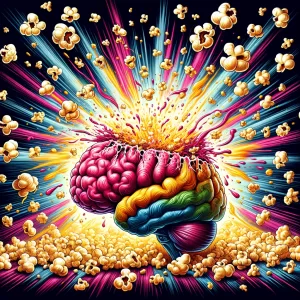 Ever wanted to binge-watch an uplifting show but couldn’t make it more than five minutes without looking at your phone? You might be struggling with “popcorn brain.” The buzzy term describes what happens when your attention bounces from one task or topic to another, like popcorn kernels popping in the microwave.
Ever wanted to binge-watch an uplifting show but couldn’t make it more than five minutes without looking at your phone? You might be struggling with “popcorn brain.” The buzzy term describes what happens when your attention bounces from one task or topic to another, like popcorn kernels popping in the microwave.
Popcorn brain becomes a problem when excessive screen time—and constant notifications—limit your capacity for undivided attention. So let’s learn more about this tendency, and how you can regain focus with some manageable lifestyle changes.
What Is Popcorn Brain?
“Scrolling through social media can lead to what’s colloquially termed ‘popcorn brain,’ a state characterized by distraction, impulsivity, and a diminished attention span,” explains clinical psychologist Sanam Hafeez, PsyD.
“Popcorn brain” became popular after it was first used by quality-of-life researcher David Levy in 2011. Levy referred to it as “being so hooked on electronic multitasking that the slower-paced life offline holds no interest.” This constant influx of digital stimulation changes how our brains process information.
Licensed psychologist Andrew Kahn, PsyD, notes that the problem is exacerbated by the way modern apps and social media are designed to get us looking at our devices over and over again.
“This constant competition for our attention has caused social media platforms to shorten the bursts of information, increase the stimulation they provide, and draw our brains toward the info,” says Kahn. “The result is a notable shortening of our ability to spend extended time looking at one item on a screen (or often away from screens).”
What Causes Popcorn Brain?
Think of the last time you were disconnected from the internet for any length of time. It’s hard to remember when you were unplugged for more than a day, right? But it’s not just constant access to the internet that causes popcorn brain. Here are some other factors that influence a lack of attention.
Switching between devices and apps fragments attention
In five minutes, you might check your email, watch the news, switch back to read Facebook notifications, and then scroll some videos on TikTok. This variation of information clogs up our attention. “These platforms offer a continuous stream of stimuli, including updates, images, and videos, inundating users with information. This inundation can overwhelm the brain’s capacity to focus on any single task or idea for an extended period,” says Hafeez.
Instant gratification activates our reward system
“The intermittent rewards provided by social media, such as likes and comments, trigger the release of dopamine, encouraging users to seek more stimuli and perpetuating a cycle of compulsive behavior,“ explains Hafeez. These built-in rewards make us want to do these things even more.
This might seem like a positive thing, but when we need to tackle projects that take more time to reach that reward, it’s much more challenging to stay on task. Hafeez explains that excessive screen time “weakens the brain’s ability to sustain focus and engage in deep, sustained thought processes.”
Notifications, infinite scroll, and algorithms pull us back in
We may have every intention of focusing on cleaning the kitchen, for example, but if we hear a ding, we are conditioned to stop what we are doing and check our phones for that reward—and when we do, the algorithm pulls us back in.
“Many social media platforms and other apps are deliberately engineered to capture and retain users’ attention for as long as possible,” says Hafeez. “These design elements create an environment of constant stimulation and reinforcement, making it challenging for users to disengage and focus on other tasks.”
Once we stop a real-world task to scroll, the information is literally endless. “The infinite scroll feature common in many apps encourages users to keep scrolling, fostering a sense of endless content consumption,” says Hafeez. “These design choices contribute to a culture of distraction and impulsivity.”
The volume of information is overwhelming
Sometimes, too much of a good thing isn’t a good thing. “The abundance of information from various sources on social media can lead to cognitive overload, making it challenging to process and retain meaningful information,” says Hafeez.
This excessive information has turned us into passive rather than active participants in what we do, watch, or buy. “We’ve become highly passive consumers,” Kahn adds. “Information is always ‘on’ and in our hands (or pockets). It sometimes leads to impulse shopping and a complete disconnect from our thinking process.”
Traditional media has adjusted to our shortened attention spans
Kahn warns that the problem of popcorn brain only worsens as creators adjust to suit our current information appetites. “As a result of using screens so frequently, our attention spans have shortened dramatically, and the continual design of social media, websites, and even movies and television are now designed to accommodate these changes,” says Kahn.
How to Fix or Prevent Popcorn Brain
According to Hafeez, the impacts of popcorn brain are not necessarily permanent. “The shortened attention span resulting from excessive phone use can be reversible and neuroplasticity plays a crucial role in this process,” says Hafeez.
Fortunately, Kahn agrees. “There is every reason to believe people can make their attention spans longer again,” he says.
While improving your focus can take time and you likely won’t see changes overnight, here are some things you can try to unplug and regain your focus.
Adjust screen time settings
Most phones now have the ability to regulate our screen time and block certain apps after a designated period. In the beginning, you may not have the willpower to put the phone down, so these systems can help build a habit of less screen time.
Use the Pomodoro Technique
To help you focus on a single task for longer (without a phone in hand), try The Pomodoro Technique to give you a reasonable start and stop time. In short, you’ll set a timer to work for 25 minutes, followed by a short five-minute break. Repeat throughout the day, with longer breaks every two hours.
Set up tech-free zones
“Setting boundaries on phone use, such as implementing designated ‘phone-free’ times or rooms, can reduce the constant stimulus that contributes to a shortened attention span,” says Hafeez.
It may be unrealistic to be away from tech at your desk, for example. But are there spaces in your home where you can put all devices down? If the space is indoors, make it cozy and inviting. If there’s no space inside, find a spot in nature where you feel safe going without your phone. When you take a break after focusing on a task, spend this time in a tech-free zone.
Exercise your mind and body more often
“Regular physical exercise has been shown to enhance cognitive function and promote neuroplasticity, which can support the brain’s ability to recover from the effects of excessive phone use,” says Hafeez. But don’t forget your mind, too. “Engaging in activities that challenge cognitive abilities, such as puzzles, learning new skills, or engaging in intellectually stimulating conversations, can help improve attention span and cognitive function,” Hafeez adds.
Seek support if you need more help
Sometimes, professional or social support can help with a lack of focus. Certain therapy modalities, like CBT (cognitive behavioral therapy), can help you reframe your thoughts, which, in turn, could be helpful for emotional regulation. “Practicing mindfulness about social media habits, joining support groups, and reflecting on personal values and priorities can further aid in reducing addiction,” says Hafeez.
When to Consult With a Mental Health Professional
Hafeez and Kahn share some signals that you may need additional support if the lifestyle changes above aren’t helping.
- Persistent symptoms like difficulty concentrating, impulsivity, and a diminished attention span despite attempts to limit social media usage
- Social media habits significantly affect daily functioning, such as work, sleep, in-person relationships, or academic performance
- Increased distress, anxiety, or depression linked to social media use
- Inability to reduce social media consumption despite recognizing its adverse effects
- Inability to do anything or go anywhere without a device in hand
- Expressing worry or anxiety about missing something on your device at times when you are engaged in other important life tasks
“The key factor in deciding when to get help is to honestly evaluate if your technology use is impairing your functioning in an essential life area,” says Kahn. “Counseling can be super helpful in helping clients create plans for managing their time/tasks, engage in alternative activities in daily life, and becoming more aware of the influence of media and tech on their lives.”
You don’t need a diagnosable mental health condition to benefit from therapy. “If social media usage negatively impacts mental health, seeking assistance from a mental health professional can provide support, guidance, and strategies to address concerns and promote overall well-being,” Hafeez adds.




